
The Bleeding Wilds
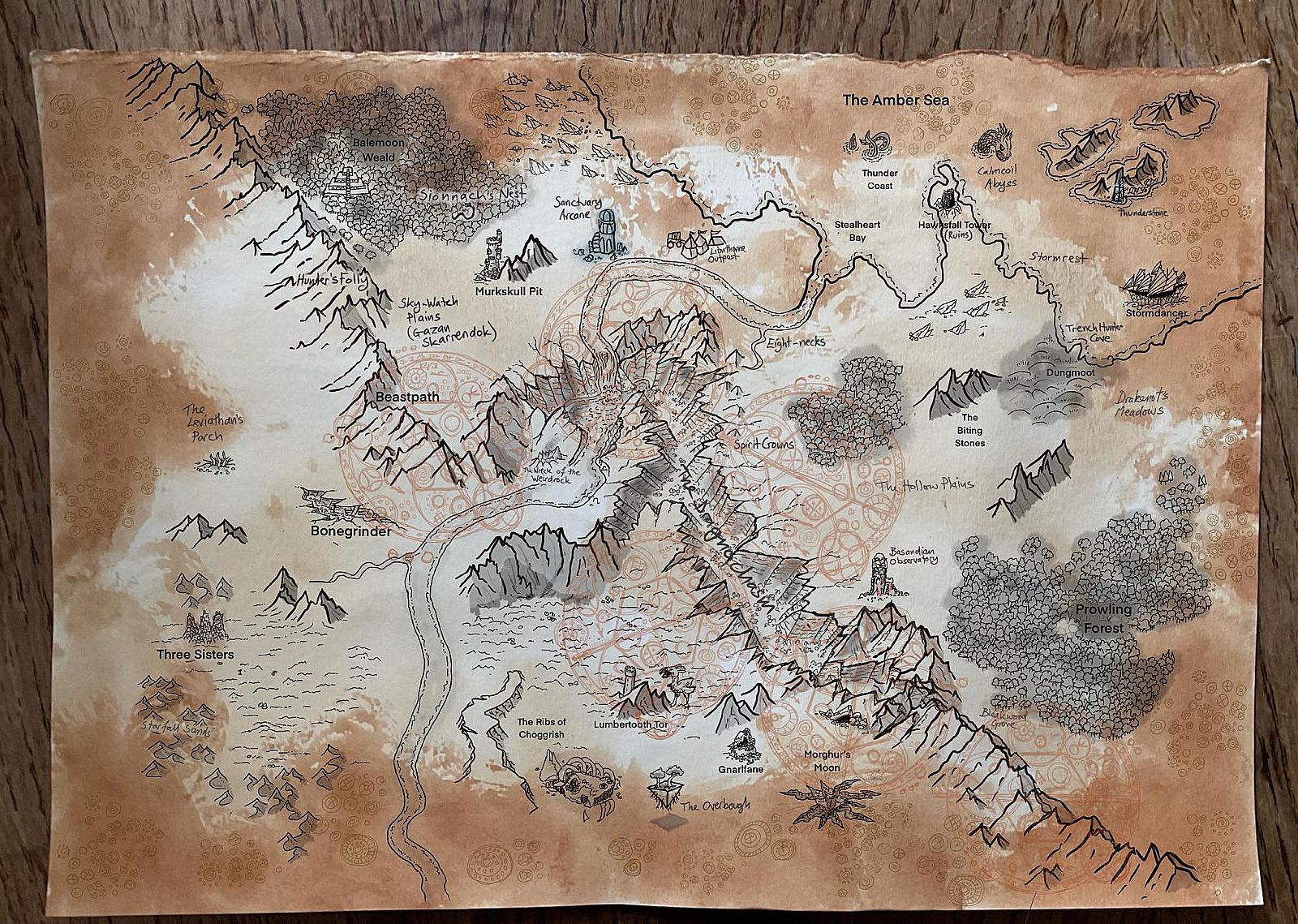 (Epilogue map of the Scarlands - the aftermath of the Bleed)
(Epilogue map of the Scarlands - the aftermath of the Bleed)
“The Bleeding Wilds is a shifting, mercurial landscape across which the phenomenon known as the Bleed rolls. One moment, you can be crunching along a teal, crystalised shore, the next, you may find yourself stumbling through a dense meadow of feastbracken.
Despite its inconstancy, the Bleed only affects two locations, albeit vast ones. These are Silverside in the Realm of Metal and the Badlands of Lahar in the Realm of Beasts. Broadly speaking, the Badlands of Lahar are a dry, dusty place of ochre sands, punctuated by umber rocky outcrops. In contrast, Silverside has been all but drowned by the flooding Ur-River, and once proud mountains are now crowded islets. For all their differences, the topography of these lands is curiously similar, to the point where the mountain ranges that split the two regions are near-identical. Thanks to these similarities, rarely does the shift in realms lead to a deadly drop or a premature burial. Rarely but not never.
The flooding of Silverside means that huge tracts of the Badlands of Lahar can be unsafe to travel through, should the Bleed shift you beneath the crushing weight of the floodwaters. Mercifully however, the Bleed is a relatively slow-moving phenomenon. Weeks may go by where merchants, explorers and warriors can freely cross the gorges of Lahar but when the shimmering wave of magic rolls over the mountains and along the valleys, the floodwater follows, suspended in a strange cross-section of aquatic life. Some travellers tell stories of being chased down gorges by roaring walls of shimmering magic. Listen to these tales while you can, for these foolish souls tend not to last long in the Bleeding Wilds.”
The Badlands of Lahar, Ghur
Vast tracts of ochre sands, punctuated by umber rocky outcrops, stretch from the Dragonspine Mountains for hundreds of leagues. To the south and west, there are sandy deserts to the Lahar Caldera and beyond.
The Dragonspine Mountains
Winding from north-west to south-east across the Badlands, this mountain range divides the dry, sandy and rocky lowland desert to the south from the swampy forests and highland jungles to the north. The waters of the Stealheart River crash down the Dragonspire Falls in the centre of the range, flowing south.
The Dragonchasm
(Regions 19, 20, 21, 29, 30, 39, 40, 42, 43, 45, 58, 59 and 60!) Like a vast scar across the centre of Lahar, the Dragonspine mountains were ripped open by the awakening of Maurda Rua. The land itself is broken open. The chasm is wide and deep, the bottom is unevenly covered with the rubble of the smashed peaks. Its sides are cracked and shattered, peeled back in great creases. The northern end is filled by a new lake, from which the river spills out into the lowlands through a rent in the side. (Updated)
Region G2 – The Balemoon Weald
A deep and heavily-wooded valley not far from the Thunder Coast. The Weald is a primordial jungle, wild and overgrown and teeming with huge reptilian monsters. At its heart is a crumbling stone ziggurat that is almost entirely lost to the trees and vines.
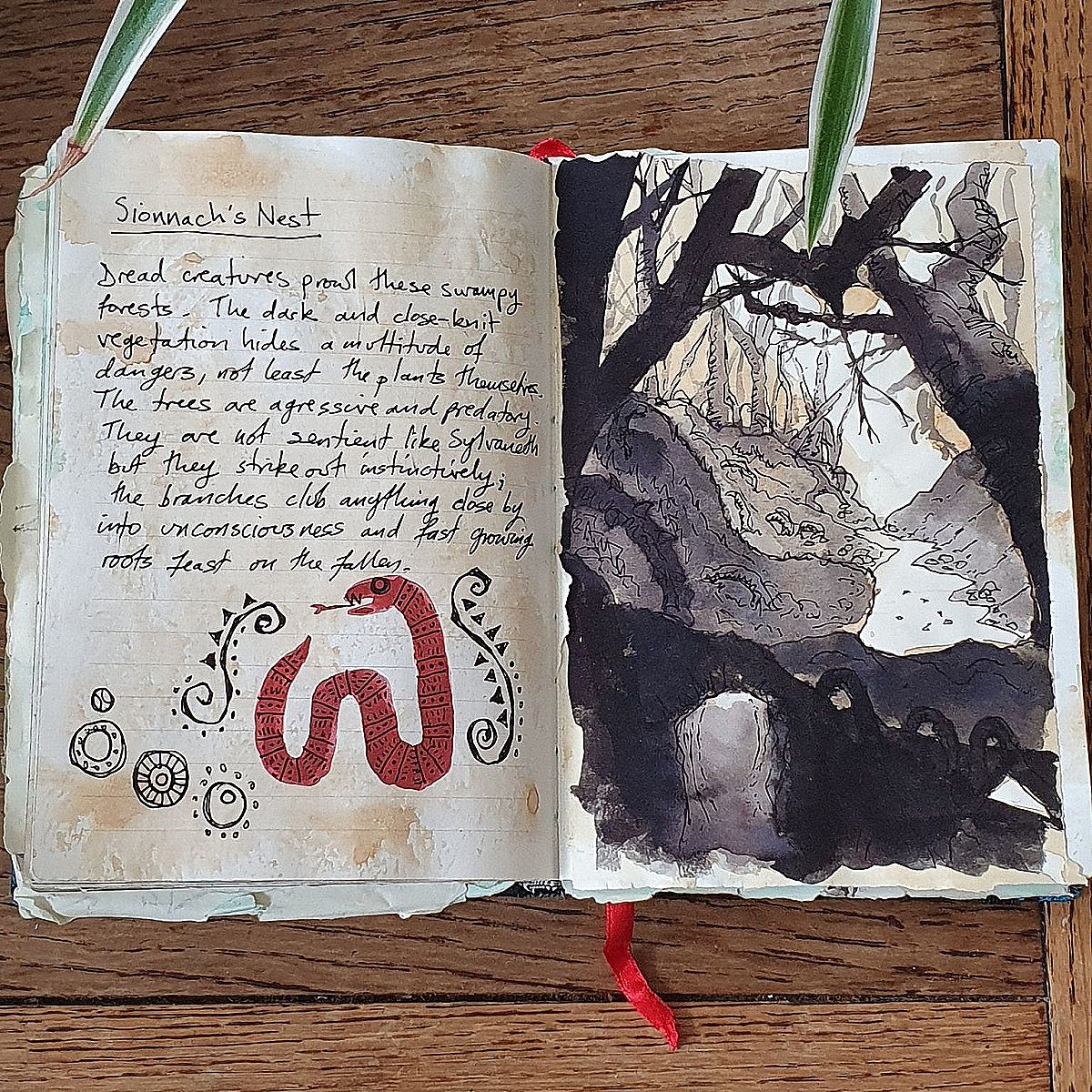
Region G3 - Sionnach's Nest
Dread creatures prowl these swampy forests. The dark and close-knit vegetation hides a multitude of dangers, not least the plants themselves. The trees are aggressive and predatory. They are not sentient like Sylvaneth but they strike out instinctively; the branches club anything close by into unconsciousness and fast-growing roots feast on the fallen. (Updated)
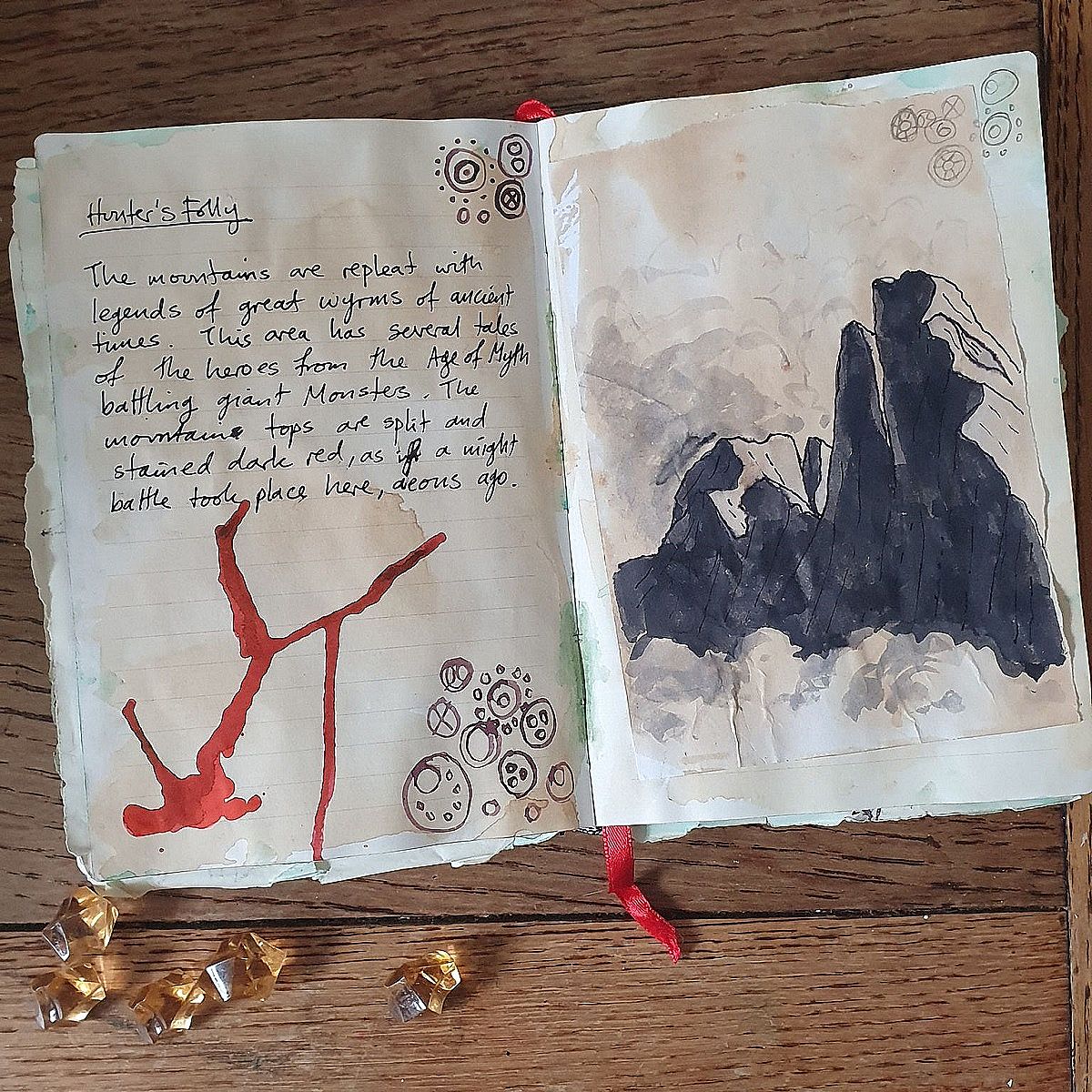
Region G5 - Hunter's Folly
The mountains are replete with legends of great wyrms of ancient times. This area has several tales of the heroes from the Age of Myth battling giant monsters. The mountain tops are split and stained dark red, as if a mighty battle took place here, aeons ago. (Updated)
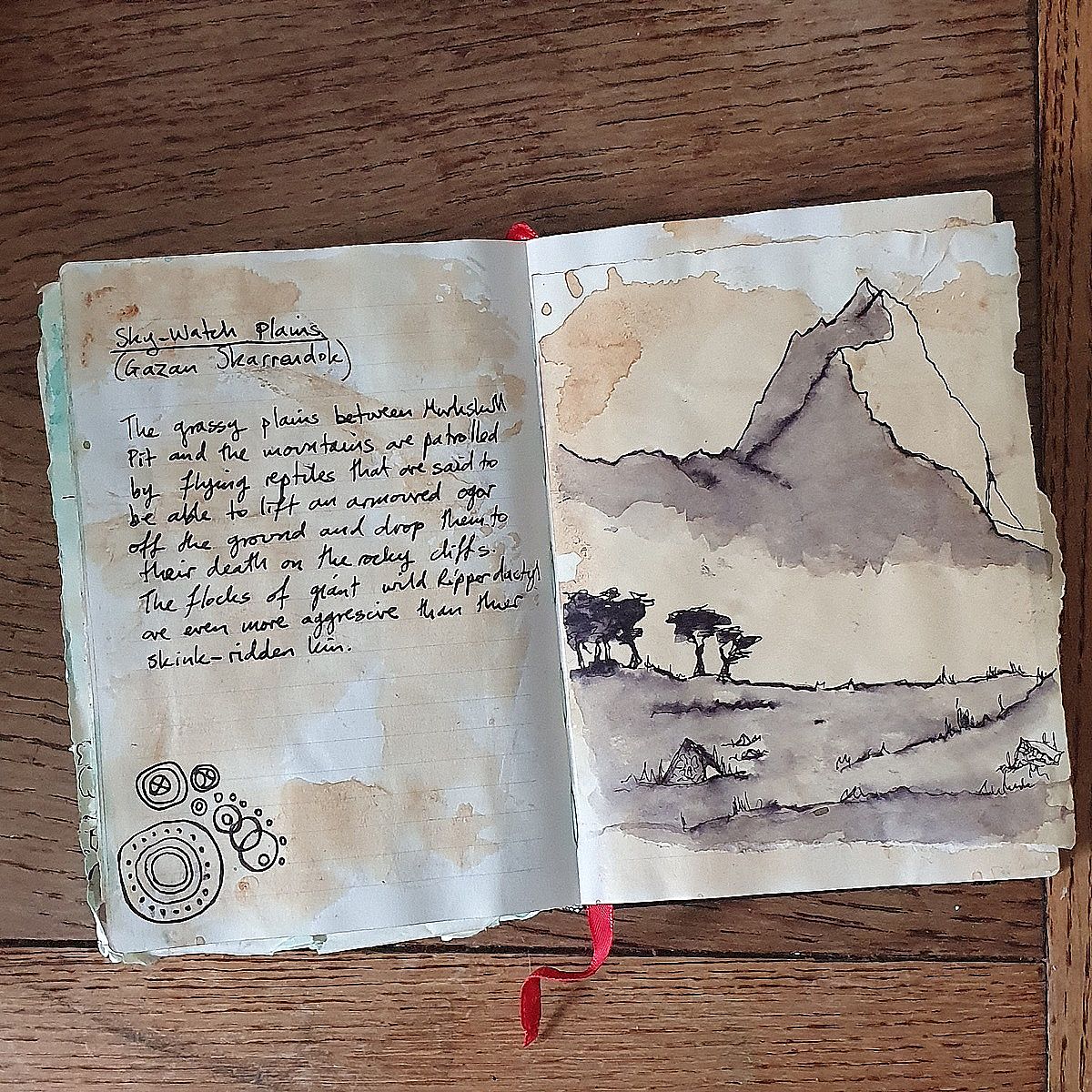
Region G6 - Sky-Watch Plains (Gazan Skarrendok)
The grassy plains between Murkskull Pit and the mountains are patrolled by flying reptiles that are said to be able to lift an armoured ogor off the ground and drop them to their death on the rocky cliffs. The flocks of giant wild Ripperdactyl are even more aggressive than their skink-ridden kin. (Updated)
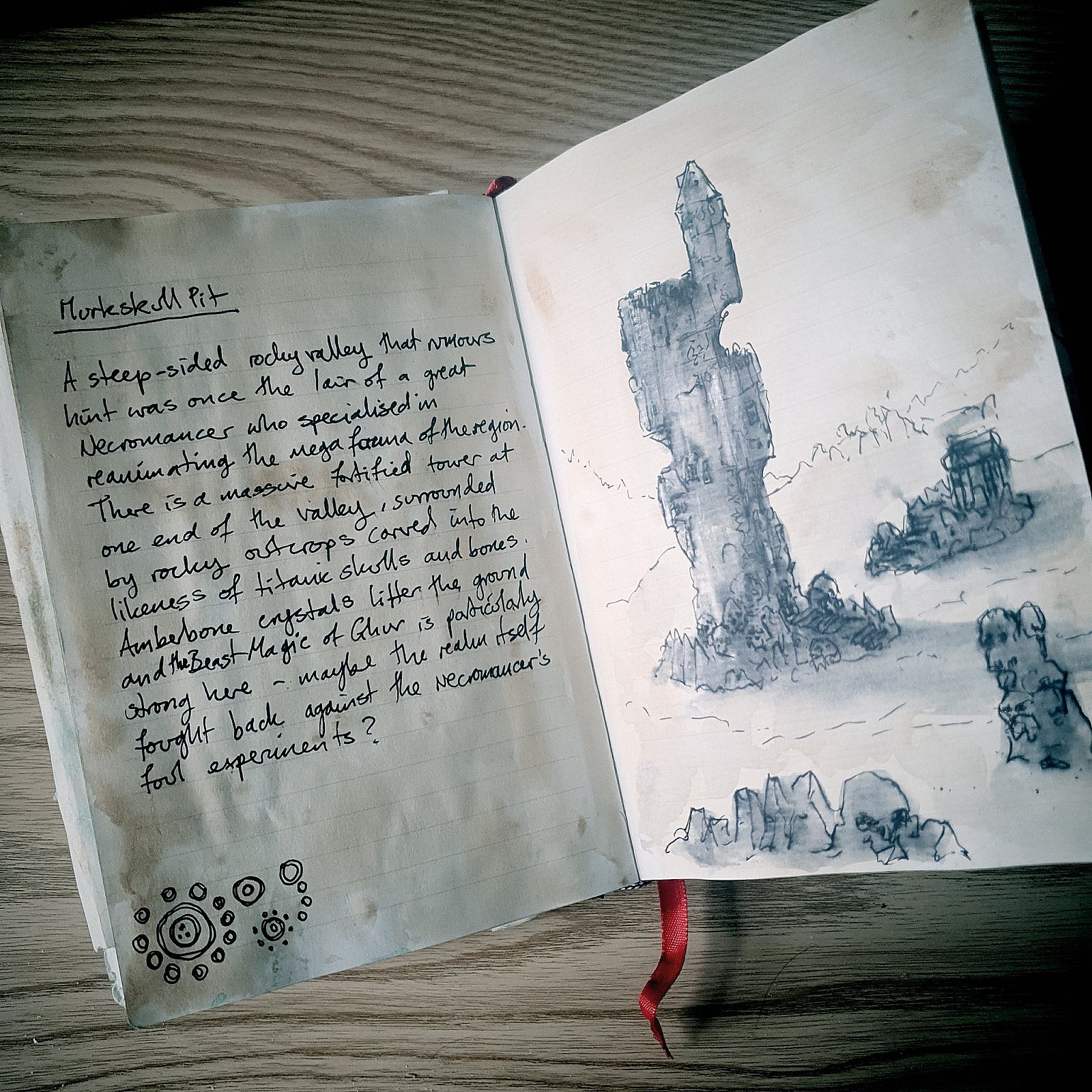
Region G7 – Murkskull Pit
A steep-sided rocky valley that rumours hint was once the lair of a great Necromancer who specialised in reanimating the Megafauna of the region. There is a massive fortified tower at one end of the valley, surrounded by rocky outcrops carved into the likeness of titanic skulls and bones. Amberbone crystals litter the ground and the Beast Magic of Ghur is particularly strong here - maybe the realm itself fought back against the Necromancer’s foul experiments? (Updated)
Region G8 - The Sanctuary Arcane
The Sanctuary Arcane had been torn from the heart of Chamon and now rested within the ever-hungering landscape of Ghur. A small complex of turquoise-stone buildings with golden domes amid the remains of the Age of Myth city that was called Draschel. Most of the buildings were in ruins, scattered columns and broken statues litter the area, but a few domed towers are still intact. Both ruins and whole structures are surrounded by white-barked dead trees and scrubby yellowed grass. The Sanctuary Arcane was the stronghold of a great wizard and his treasures still remain, locked away behind sorcerous wards and glyphs of power. The first steps of rebuilding the ancient city have begun. (Updated)
Region G9 - Unnamed
Hundred-strong clusters of silvery-blue crystals have appeared, arranged in strange geometric patterns. The air shifts around them, distorted as if by heat that cannot be felt. The energy contained within the crystals is strangely ordered and rhythmic. As if it contains a pattern or a memory. Explorers have reported an odd clarity of thought and focus when touching the crystals. (Updated)
Region G10 - Lionthorne Outpost
The nomadic outpost of sumptuous tents, colourful yurts and wagons has relocated to the coast near the Sanctuary Arcane. Inside embroidered hangings and tapestries cover the walls of the tents and yurts, piles of tasselled cushions and brightly coloured rugs and blankets cover the floors. Outside bunting, flags and ribbons flutter in the wind from every tentpole. Arcane symbols are painted, printed or sewn onto every surface. One particularly huge wagon has a portable library inside. Books, scrolls, trinkets and jewellery fill every corner. (Updated)
Region G11 - Truesilver Depths
The Amber Sea churns in a tight downward spiral and the currents and the seafloor interact to create a terrifying undertow that can capture and crush even the largest ship or mega-predator. At the bottom of the sea is a sunken temple. (Updated)
Region G12 – Thunder Coast
A lightning-wracked coast of the stormy Amber Sea.
Region G13 – Hawksfall Tower
A lighthouse from the Age of Myth on the Thunder Coast, marking the entrance to Stealheart Bay. Built from local stone, on top of a massive rocky outcrop at the tip of a long isthmus. The previous owner was known as a seer who could see visions of an ancient ur-wyrm when holding a compass made from mountain stone. The tower had survived assault from weather, monsters, raiders and earthquakes ... until the whole Lighthouse was plunged into withering, unforgiving verdant flame and it tumbled down into a useless shell. (Updated)
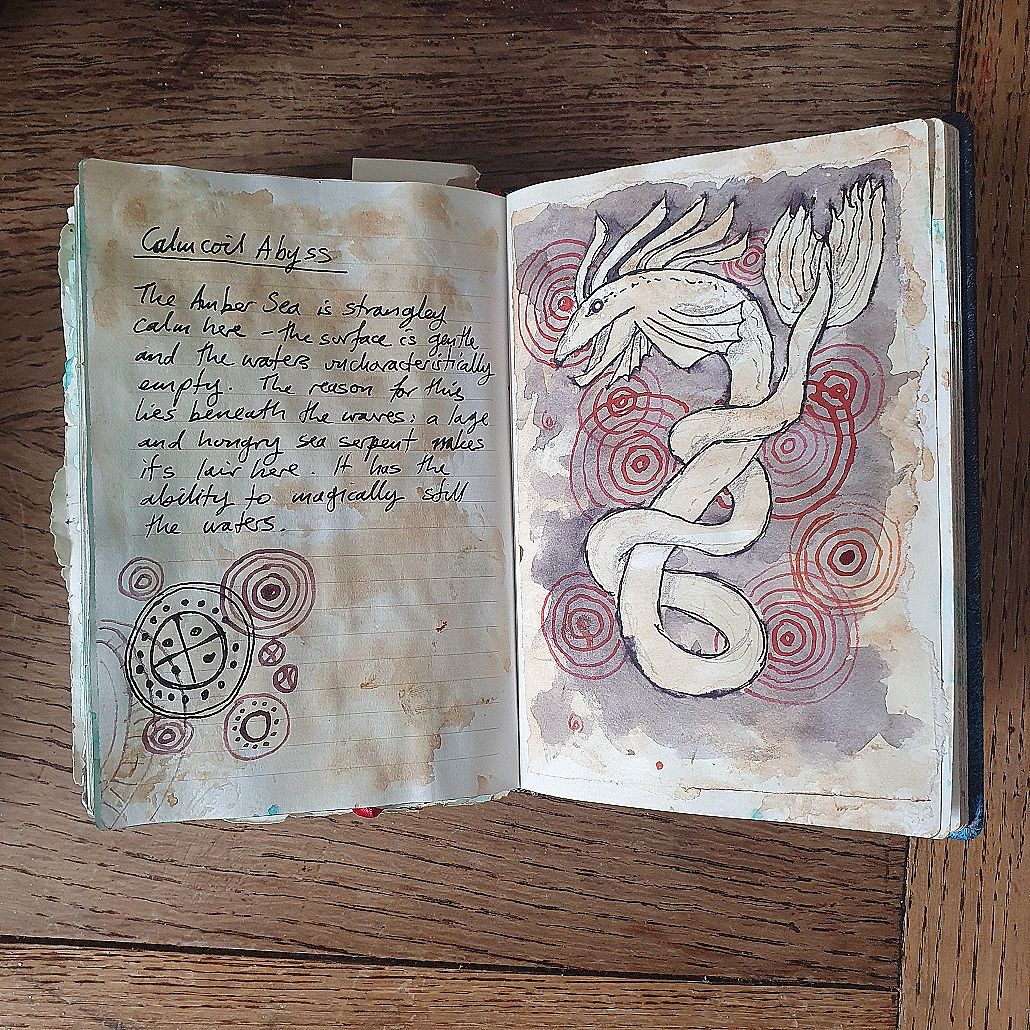
Region G14 - Calmcoil Abyss
The Amber Sea is strangely calm here - the surface is gentle and the waters uncharacteristically empty. The reason for this lies beneath the waves, a large and hungry sea serpent makes its lair here. It has the ability to magically calm the waters. (Updated)
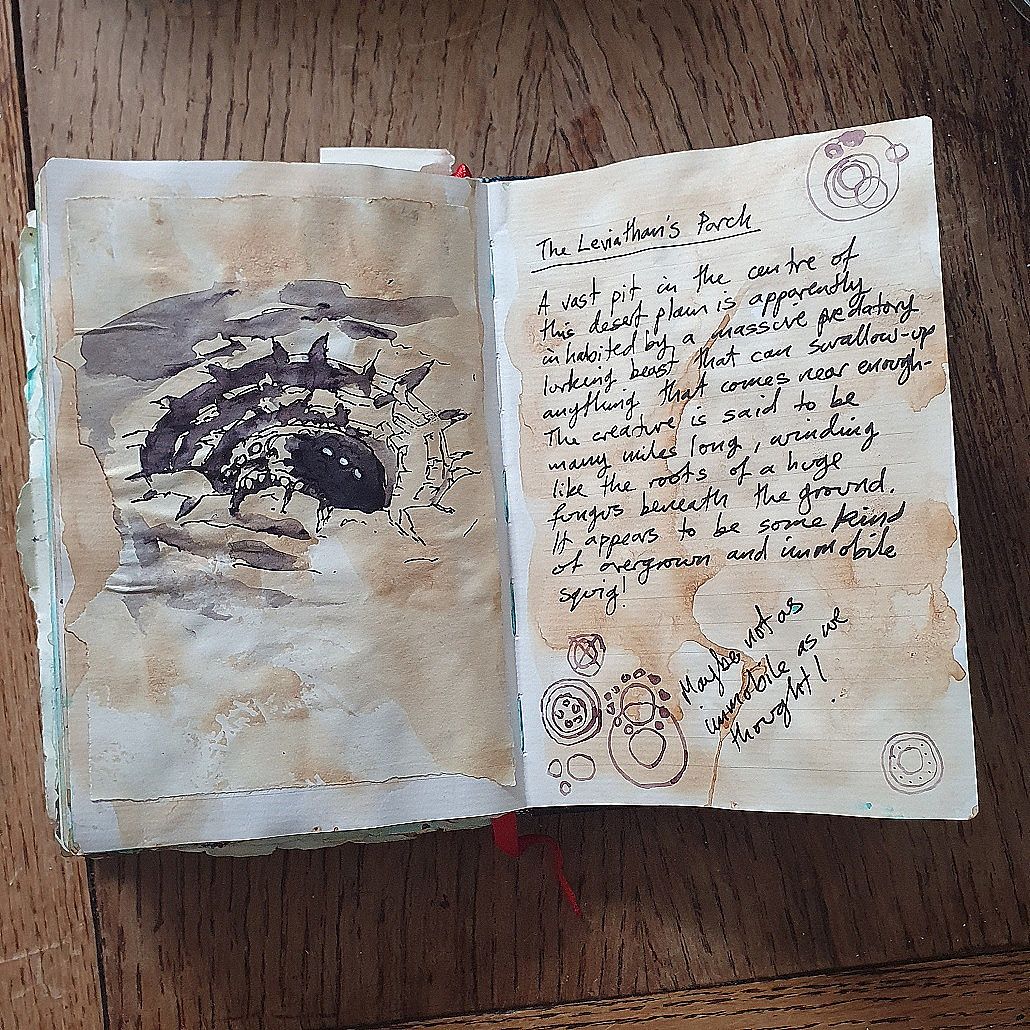
Region G16 - The Leviathan's Parch
A vast pit in the centre of this desert plain is apparently inhabited by a massive predatory lurking beast that can swallow-up anything that comes near enough. The creature is said to be many miles long, winding like the roots of a huge fungus beneath the ground. It appears to be some kind of overgrown and immobile squig! (Updated)
Region G18 – The Beastpath
A narrow winding road through the southern Dragon-spine Mountains, littered with the ruins of castles, watchtowers and strongholds. Each one tells the tale of some petty warlord who tried, and failed, to control the mountain pass. (Updated)
Region G19 – Barak-Drak Sky-Port
Sky-ports are the massive floating metropolises of the Kharadron Overlords. These bustling hubs of trade and military strongholds are capable of drifting vast distances to reach new prosperous lands. While being some of the greatest centres of trade and industry in the Mortal Realms, the sky-ports maintain enough firepower to be all but impervious to frontal assaults.
But Barak-Drak is not floating – it was brought down by the first occurrence of the Bleed and crashed in the Drake-spine Mountains. The city-sized port is heavily damaged. Many of its functions have been partially or even completely shut down as resources are redirected to repairing the sky-port and getting it airborne again. The metal walkways of the labyrinthine streets and cramped passageways are lit with sputtering whaleen-oil lamps. The Endrintrams that once provided inhabitants with rapid transit throughout their sky-port have all been shut down to conserve resources.
Region G19 – Red Maud
The tallest mountain peak in the Dragon-spine range. Legends tell of a great dragon that lived here before the Age of Myth, and it now seems like they are more than just stories!
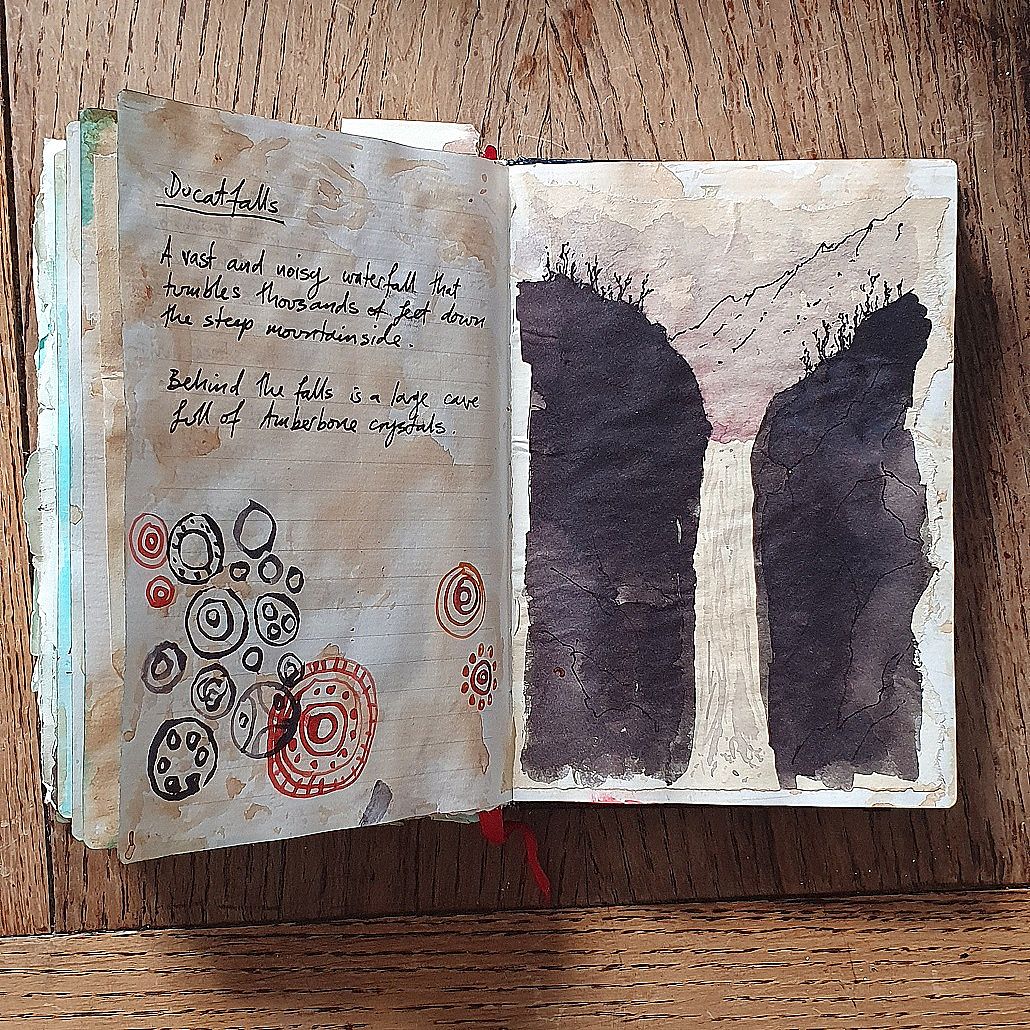
Region G20 - Ducatfalls
A vast and noisy waterfall that tumbles thousands of feet down the steep mountainside. Behind the falls is a large cave full of Amberbone crystals. (Updated)
Region G22 – Stealheart Bay
A wide estuary at the mouth of the Stealheart River where it flows from the Amber Sea. The clear waters are teeming with large and small predatory fish but too shallow for the mega-predators of the Amber Sea to hunt. The river fishes’ scales have become metallic and hard, their fins and teeth have been strengthened and they now prey upon the mega-predators of the sea! An airy underground cavern lies beneath the waters, with strange carvings covering the walls, leering fanged faces peer downwards. At its far end a statue to some unknown bat-like god stands tall.(Updated)
Region G24 - Stormrest
On the shores of the Amber Sea there was once a small port town, but now there are only ruins left to attest to that fact. The remains of the stone-built walls stand hollow and surrounded by salted soil, where even grass won’t grow. Nothing that was made from timber endures. The basements of a few buildings might still contain lost treasures, but they will need to be dug out as they are no longer empty spaces and the ground above sank into them centuries ago. (Updated)
Region G25 – The Stormdancer
The Stormdancer is a Black Ark; a ship that is also a fortress-city of the corsairs, privateers and pirates – it serves as the flagships of a Scourge armada and a personal fiefdom. The vessel does not actually float on its own but it is built on the back of an oceanic behemoth. The Stormdancer has an imposing silhouette with many spined and bladed towers and spires. Some of the orruk crew have taken to making “improvements” to the Ark and a number of new wooden and metal-plated structures have appeared – they are asymmetrical, ramshackle and distinctly wonky-looking.
Region G27 – The Bonegrinder
A deep chasm in the Badlands, filled with the bones of megafauna. The chasm seems to move, either through minor earthquakes or with a life of its own - the giant bones are often displaced or shifted. Some are even crushed by the movements of the stone walls. (Updated)
Region G29 – Breakwall Gate
The central mountain-pass through the Dragon-spine Mountains, upon which Barak-Drak has fallen. Once occupied by a fierce band of orruk bandits, who called themselves the Breakwall Bashas, but they fled when the sky-port crashed on their Boss. A number of Great Gnashtoofs still roam the area, preying on the huge and angry wild boars that feed here. (Updated)
Region G29 - The Wreck of the Weirdrock
The floating sky-island drifted across the region for many weeks. It moved slowly, only a few miles each day, so it was not impossible to keep up with it if travelling over the ground below it. The island was usually a few hundred yards above the land directly beneath it, and it gently rose and fell as it passed over hills and mountains. A rapidly expanded shanty-town had been hastily constructed from the materials that were available. The wooden buildings clung to the top and sides of the rock and a number of mechanical cage-lifts were set up to allow the residents easier access. The remains of the sky-island smashed into its last resting place on the valley floor when a vast mega-Incarnate was created in its core and broke out.
Region G31 - Eight-necks
A tributary flows into the Ur-River from the mountains near the lair of a many-headed serpentine creature. The enormous overgrown Kharybdis found a treasure that it defended ferociously. It kept the prize hidden in its cave under a pile of the bones and teeth of the monster’s previous meals. (Updated)
Region G33 – The Biting Stones
The Biting Stones are two smaller mountain ranges that have been battling each other for centuries - local legends say that they clash every few decades; smashing together in a titanic struggle of landslides, earthquakes and volcanic eruptions, then withdraw to recover, in a slow-moving battle that mortals can barely perceive. But the mountains themselves are not the only danger here - there are packs of vicious Gnarltongues prowling the craggy slopes. (Updated)
Region G34 – Dungmoot
A black fen. The air is filled with an unpleasant sulphurous odour. The swamps are suffused with will-o'-the-wisps that burn with the intensity of a magnesium flame. Ghurish aquatic predators move through the shallow waters with surprising ease. (Updated)
Region G35 – Three Sisters
A desert city, built on three vast rocky outcrops surrounded by dunes. The sheer sides of the cliffs are covered with stone and timber buildings, built in front of caves carved into the rock. Roads wind around the outside of the massive outcrops and dozens of bridges span the gaps between them. Many of the buildings have windmills built into them to make use of the abundant free energy - to power mills, winches, lifts, saws, water pumps, etc. The peoples of the Three Sisters are hardy and enterprising, their most prized resources are their three Aqualiths (metaliths of Ghyran held aloft by the Geomantic Magic that courses through them). Fresh water continually pours forth from the Aqualiths, raining down in torrents into great carved cisterns deep within each of the rocks. Wild Corpse-Rippa Vulchas often perch on the summits of the Three Sisters during the day. (Updated)
Region 38 - Unnamed
This parched spur of the Dragon-spine mountains gets no rain and is buffeted by the dry winds that spiral from the desert below. It hides a narrow rocky valley containing a row of statues, each 50 yards high and carved into an alcove the walls of the rock itself.
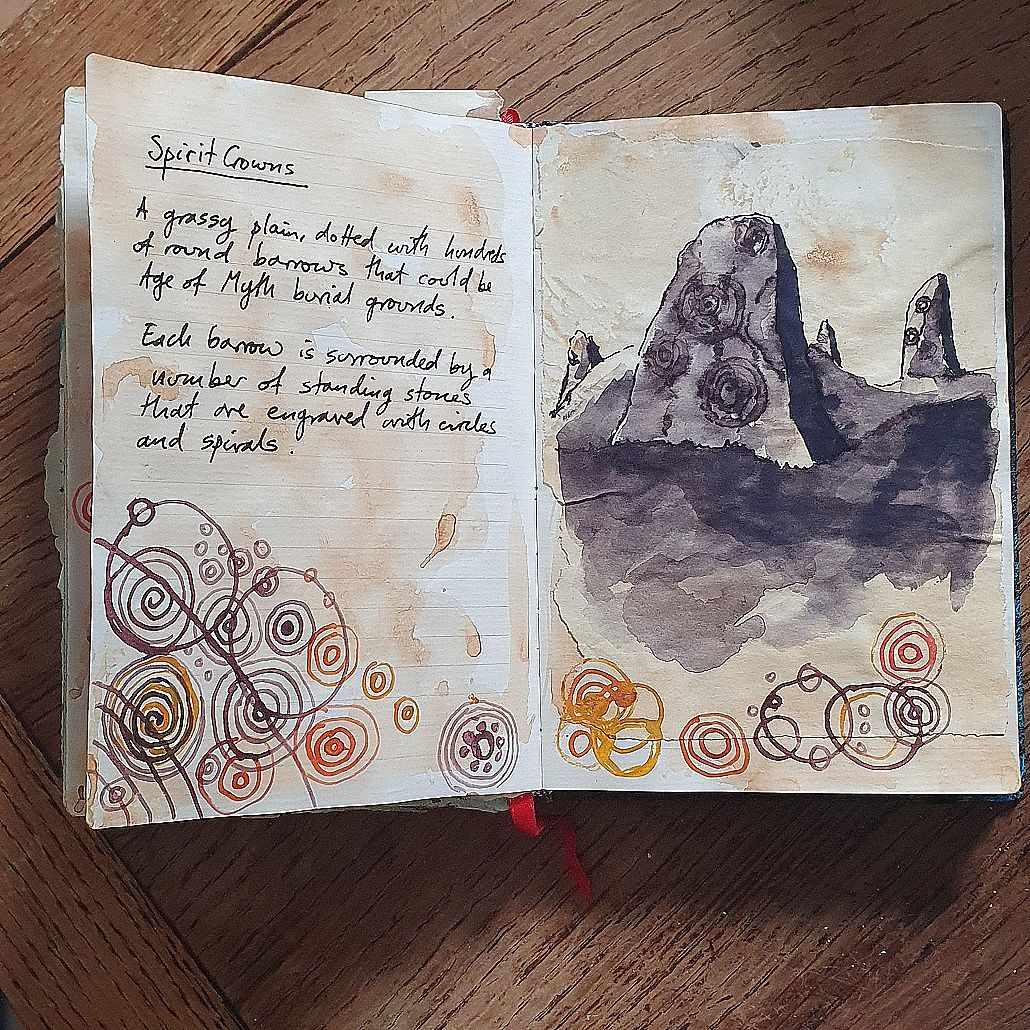
Region G41 - Spirit Crowns
A grassy plain, dotted with hundreds of round barrows that could be Age of Myth burial grounds. Each barrow is surrounded by a number of standing stones that are engraved with circles and spirals. (Updated)
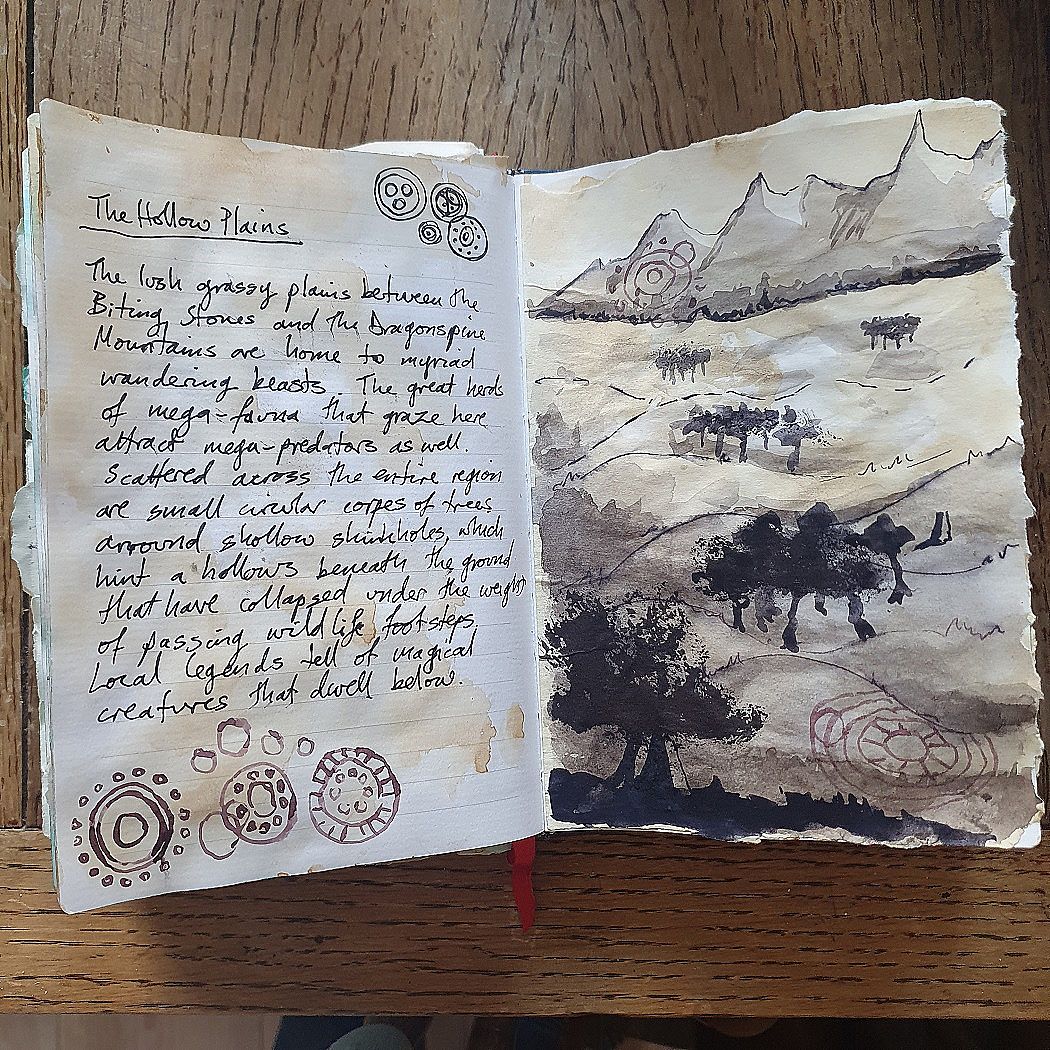
Region G44 - The Hollow Plains
The lush grassy plains between the Biting Stones and the Dragonspire Mountains are home to myriad wandering beasts. The great herds of mega-fauna that graze here attract mega-predators as well. Scattered across the region are small circular corpses of trees around shallow sinkholes, which hint at hollows beneath the ground that have collapsed under the weight of passing wildlife footsteps. Local legends tell of magical creatures that dwell below.
The cave systems beneath the plains are the burrows of a species of tunnelling predator that bursts out of the ground beneath their prey. The creatures are thaumavores and will often attempt to grab an unwary explorer for their tasty trinkets. (Updated)
Region G45 - The Basandian Observatory
High in the wild uplands, the ancient ruins of the Refuge were rebuilt with new purpose. The Immortis Ossiologists had raisied up the walls of a scholarly outpost from a foundation built upon the bones of rival explorers. The Basandian Observatory, as it came to be called, would serve as a centre of learning and launching point for future expeditions in the region. (Updated)
Region G47 - Unnamed
The Biting Stones are two smaller mountain ranges that have been battling each other for centuries - local legends say that they clash every few decades; smashing together in a titanic struggle of landslides, earthquakes and volcanic eruptions, then withdraw to recover, in a slow-moving battle that mortals can barely perceive.
Region G48 - Drakenot's Meadows
A verdant grassland plain, with gently rolling hills that slope down to a valley around the mountains known as the Biting Stones. The grasslands are home to packs of Badgerwolves. The hulking beasts are omnivorous and are usually content to dig up their food on the plains, but they are just as happy to run-down and slaughter explorers with their spade-like claws. (Updated)
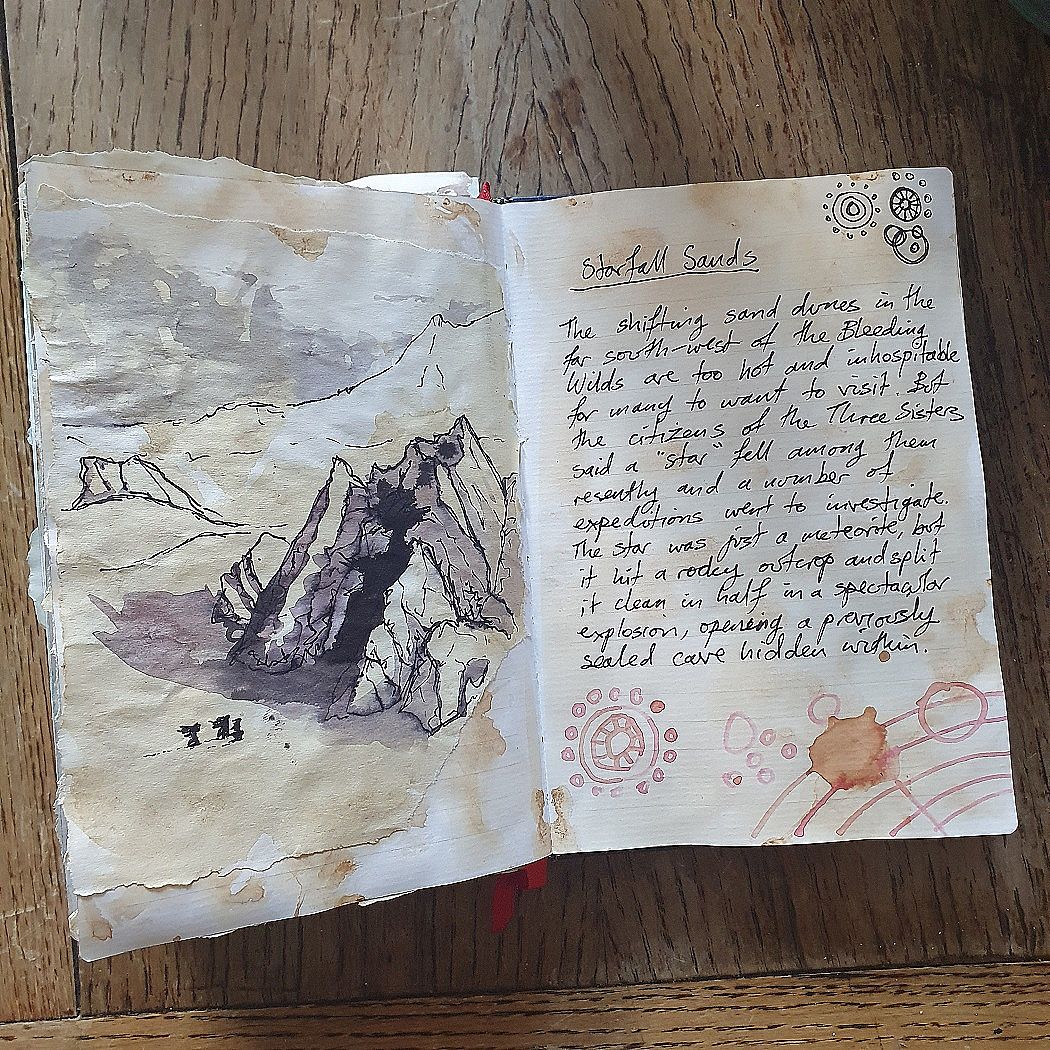
Region G50 - Starfall Sands
The shifting sand dunes in the far south-west of the Bleeding Wilds are too hot and inhospitable for many to want to visit. But the citizens of the Three Sisters said a “star” fell among them recently and a number of expeditions went to investigate. The star was just a meteorite, but it hit a rocky outcrop and split it clean in half in a spectacular explosion, opening a previously sealed cave hidden within! (Updated)
Region G53 - Unnamed
The Ur-River flows south here and many large beasts come to drink. The atmosphere is often one of tense truce between predator and prey.
Region G54 - Unnamed
A new rocky ridge, only somewhat higher than the desert on either side, beset by high winds from the mountains. It is now the favourite haunt of many large birds of prey, with shimmering multi-coloured feathers.
Region G55 - Unnamed
Windy badlands of yellow sands and rocky broken ground that makes for very slow travel overland.
Region G56 – The Ribs of Choggrish
The ossified remains of some vast megafauna lie half-buried in the ochre sands, like the curved bars of a cage standing hundreds of feet tall. Within the titanic bones an adobe-built settlement has been established, the settlers within call both the long-dead creature and their outpost Choggrish. The settlement is heavily fortified; some of the ancient bones have been shifted and lashed together to form walls and watchtowers. The hunter cultists from the nearby Gnarlfane and the massive Lumbertooths both make life hard for the settlers. (Updated)
Region G57 – Lumbertooth Tor
This lone hill, with a spiral path leading to the summit, stands high above the surrounding plains, and would provide an excellent lookout point if it were not for the hungry Lumbertooths that have made it their roost. The massive flightless birds can easily snap a tree in half with their powerful beaks.
Region G58 – The Gnarlfane
Vast swathes of titanic boneyards and ancient slaughter grounds lie around a great stone megalith that has become the centre of a hunter cult. Cultists gather here periodically to pile up the bones of the beasts slain on their unending hunts. The standing stone is carved into the likeness of a massive ungainly bird of prey, feeding on the exposed ribs of a carcass. (Updated)
Region G59 – The Weeping Cavern
A vast underground network of tunnels and caves that stretches beneath the mountains for miles. Water dripping from the ceiling forms crystal-clear pools surrounded by a variety of softly-glowing bioluminescent mushrooms. The Weeping Cavern has become suffused with necromantic energy leaking from the nearby Sepulchre. A long-dead pack of draconith once buried there have risen as a bony flock of zombie dragons within. The tunnels are also riddled with aggressive Segmapedes and Gangle-legged Git-Grabbers. (Updated)
Region G61 - Bleakwood Grove
There is a convergence of geomantic ley lines in a small grove, on the edge of the Prowling Forest. The forgotten woodland is filled with all manner of magic trees and beasts, and maybe dragonmetal. (Updated)
Region G61 – Shadowfane
A ring-shaped stone metalith a hundred yards across floated serenely in the sky amidst the towering mountain peaks, low clouds drifted along the valleys below it. It emitted a low hum that could only be heard when you looked directly at it, but not if you looked away. The stone that the Shadowfane was cut from was not from Ghur, or even Chamon. It was from Ulgu and although it wasn't Ulguan Realmstone it had many strange properties. When it was disturbed the outer stone fell away, revealing the pure black obsidian structure beneath, and with a ripping sound, a realmtear as black as night opened and swallowed the entire structure, sealing it away and vanishing in black mist. (Updated)
Region G62 – The Prowling Forest
A predatory jungle that ensnares passing wildlife (and explorers!) that linger beneath its leafy bowers. Fast-growing vines tangle the limbs of its victims and drag them to openings to be consumed in the wells of digestive fluids within the tree trunks. (Updated)
Region G64 - The Underbough (RP)
The Underbough Sepulchre was an ancient, long-abandoned incubation chamber for Draconith eggs which has been adopted by an alliance of Sylvaneth and Deathrattle Wights. An almost endless network of crypts and warrens below the mountains. At its heart, a carved stone chamber, overgrown with iron-hard vines and decorated with ornate statues and bass-relief carvings covered in a layer of faded, flaking paint. But it is now known as the "Overbough.” When the very ground was threatening to swallow the Sepulchre, then the Sepulchre itself was divorced from the earth. The Overbough Sepulchre came to hang safely in the twilit sky, an dizzyingly huge inverted pyramid, bristling with tangled roots and crowned by great trees, silhouetted starkly against the gloam. (Updated)
Region G65 – Morghur’s Moon
A broken region of labyrinth canyons, said to be the place a dark moon fell and smashed into the Realm. The bad moon was once said to have crashed there, causing a geomantic nexus to form, and a paranoid cave-shaman built an underground grotto for himself on top of it in the centre of a cursed labyrinth. (Updated)
Silverside, Chamon
Deep waters now spread outwards from the Verdigris Mountains for hundreds of leagues. The Ur-River burst its banks here and submerged the valleys entirely. What were once small mountains or tall hills in relatively verdant valleys are now isolated islands in large interconnected lakes. The lowland plains are lost from sight.
The Verdigris Mountains
Winding from north-west to south-east this mountain range divides the lakes and floodlands of Silverside into lowlands in the south-west and highlands in the north-east. The waters crash down the Verdigris Falls in the centre of the range, flowing south. The slopes of the mountains are littered with shipwrecks and the carcases of aquatic creatures, left by the receding flood waters.
Region C1 – The Smokestacks
Clouds of white smoke, that smells of sulphur, drift out of the volcanic vents. The vents themselves are tall, uneven cylinders of metal and mineral deposits. The surface of the ground between them is thin and weak in places and an unwary explorer could easily put a foot wrong and tumble through into the scalding-hot mineral soup below. (Updated)
Region C4 – Lionthorne Outpost
Sand-blasted ruins of a city in a sea of cerulean sand dunes. Sumptuous tents, colourful yurts and wagons surround the oasis in what was once a market square.
Inside embroidered hangings and tapestries cover the walls of the tents and yurts, piles of tasselled cushions and brightly coloured rugs and blankets cover the floors. Outside bunting, flags and ribbons flutter in the wind from every tentpole. Arcane symbols are painted, printed or sewn onto every surface.
One particularly huge wagon has a portable library inside. Books, scrolls, trinkets and jewellery fill every corner.
Region C5 - Flamespeaker Peaks
The mountains tower over the lakes to the south and the forests to the north. The slopes are peppered with cave openings. The caves are the home of many large burrowing creatures which are mostly harmless. (Updated)
Region C6 – The Poisoned Forest
A forest of dead trees, with blackened and stubby and burned-off branches.
Region C8 – The Sanctuary Arcane
A small complex of turquoise-stone buildings with golden domes amid the remains of the Age of Myth city that was called Draschel. Most of the buildings are in ruins, scattered columns and broken statues litter the area, but a few domed towers are still intact. Both ruins and whole structures are surrounded by white-barked dead trees and scrubby yellowed grass. The Sanctuary Arcane was the stronghold of a great wizard and his treasures still remain, locked away behind sorcerous wards and glyphs of power. (Updated)
Region C9 – Oxidisia
A barren and rugged coast of blue-green crystalline shards and turquoise coloured rock.
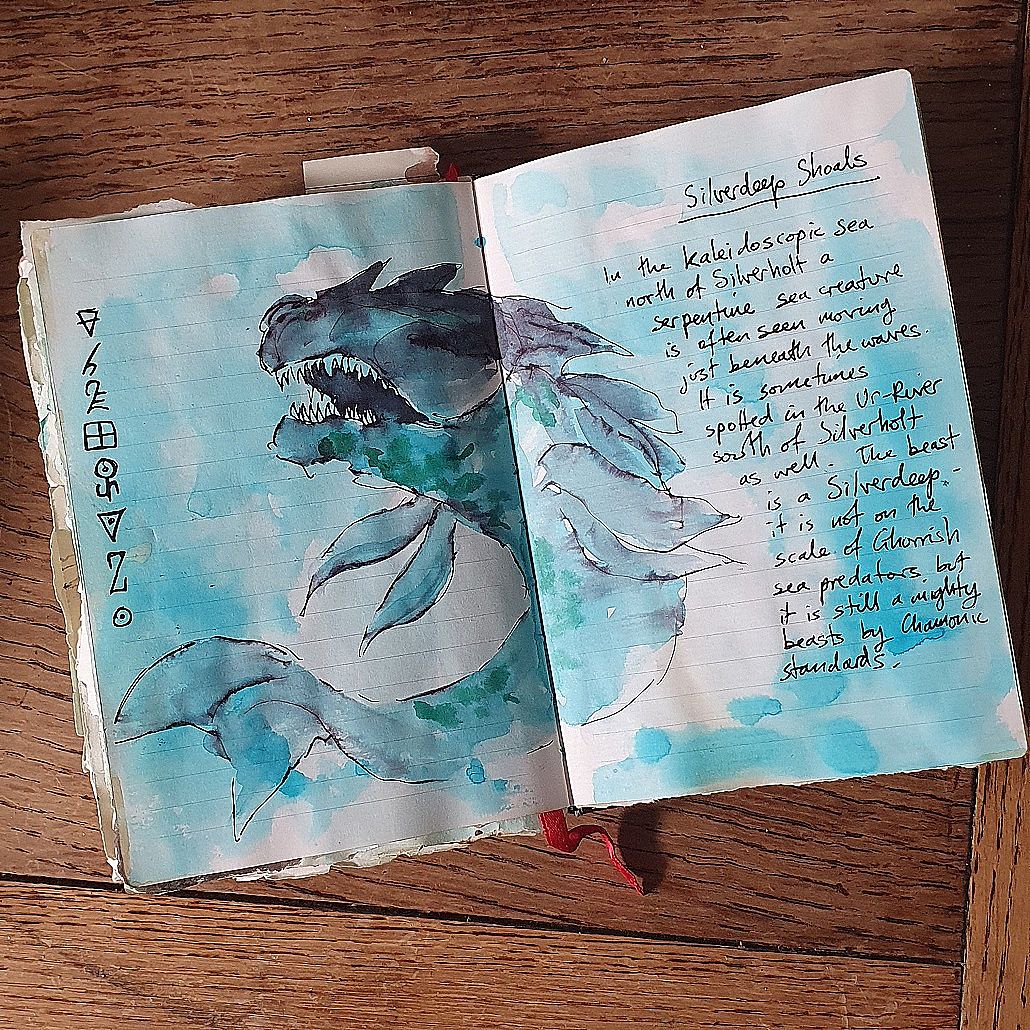
Region C10 - Silverdeep Shoals
In the Kaleidoscopic Sea north of Silverholt a serpentine sea creature is often seen moving just beneath the waves. It is sometimes spotted in the Ur-River south of Silverholt as well. The beast is a Silverdeep - it is not on the scale of Ghurrish sea predators but it is still a mighty beast by Chamonic standards. (Updated)
Region C11 - Unnamed
Under the surface of the Kaleidoscopic Sea, north of Silverholt, lies the wreck of a large ship of war.
Region C12 – The Kaleidoscopic Sea
A multi-coloured sea that reflects the light in sparkling and spiralling repeating patterns. The shapes and colours cascade and tumble over each other in the waves and the sky above. If it was not for its continuous motion, the sea would seem to be made of solid geometric crystals.
Region C15 – Thunderstone
The three islands in the Kaleidoscopic Sea are Acolyte’s Island to the north-west, Inscription Island to the north-east and the southernmost of the three is Thunderstone: A towering pillar of copper-infused rock stands on its lower slopes, visible for miles at night It loudly crackles and arcs with a near-constant lightning storm around it. Barely any wildlife dwells on Thunderstone as the danger from the storms has culled almost everything that tries. (Updated)
Region C17 – The Crucible
A partially collapsed aqueduct where a small outpost has been positioned on the windswept, but defensible, ruin. Quicksilver trickles through the pipes from a far off source in the mountains.
Region C18 - Unnamed
The mountains between the Tainted Depths (to the west) and the Poisoned Forest (to the east) are the unexpected site of a number of shipwrecks. The broken vessels are scattered over a wide area. Some are more battered and broken than others. A few may still contain their original cargos!
Region C23 – Silverholt
A large forest of pale trees that stretches along most of the coast of the Kaleidoscopic Sea.
Region C26 – Ironholt
The northern island in the Tainted Depths. The ruins of a small outpost are scattered on the shores of the lake.
Region C28 – The Prismatic Shadows
A forest of crystalline/metallic needles in a wide valley, each one between a few feet long and hundreds of feet high. The strange formations jut out of the earth at seemingly random angles. The multi-hued light that refracts through them constantly changes in a disconcerting and confusing way. Some say the whispering of the wind between the needles is actually the voices of daemons, and flocks of Tzaangors congregate in the mesmerising glimmerings. (Updated)
Region C29 – Copperwater
A flood-lake that stretches from the Prismatic Shadows in the south to the Verdigris Mountains in the north. The waters crash into the lake, over the Verdigris Falls at the northern end, down from Lake Lapis. The ruins of a town can just be seen beneath the lake waters. (Updated)
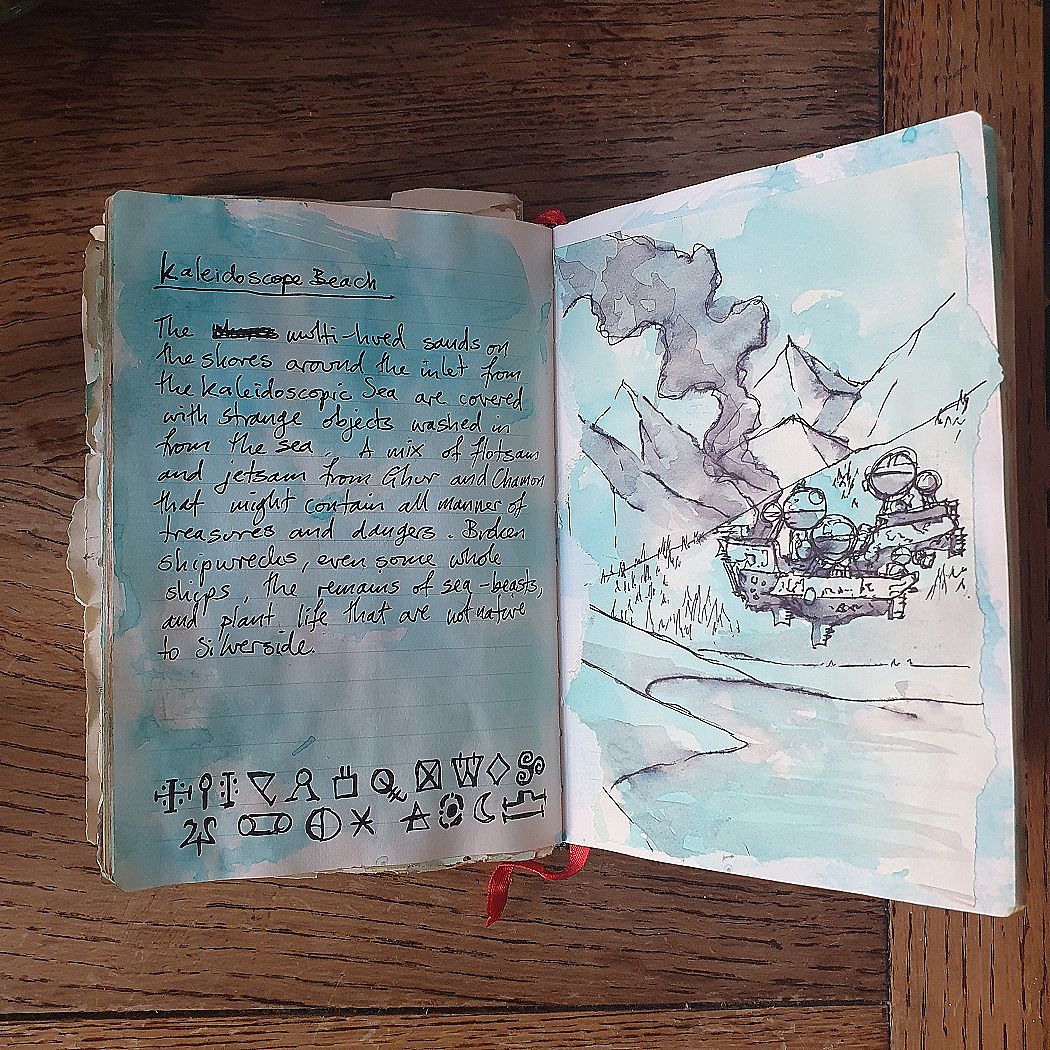
Region C31 - Kaleidoscope Beach
The multi-hued sands on the shores around the inlet from the Kaleidoscopic Sea are covered with strange objects washed in from the sea. A mix of flotsam and jetsam from Ghur and Chamon that might contain all manner of treasures and dangers. Broken shipwrecks, even some whole ships, the remains of sea-beasts and plant life that are not native to Silverside. (Updated)
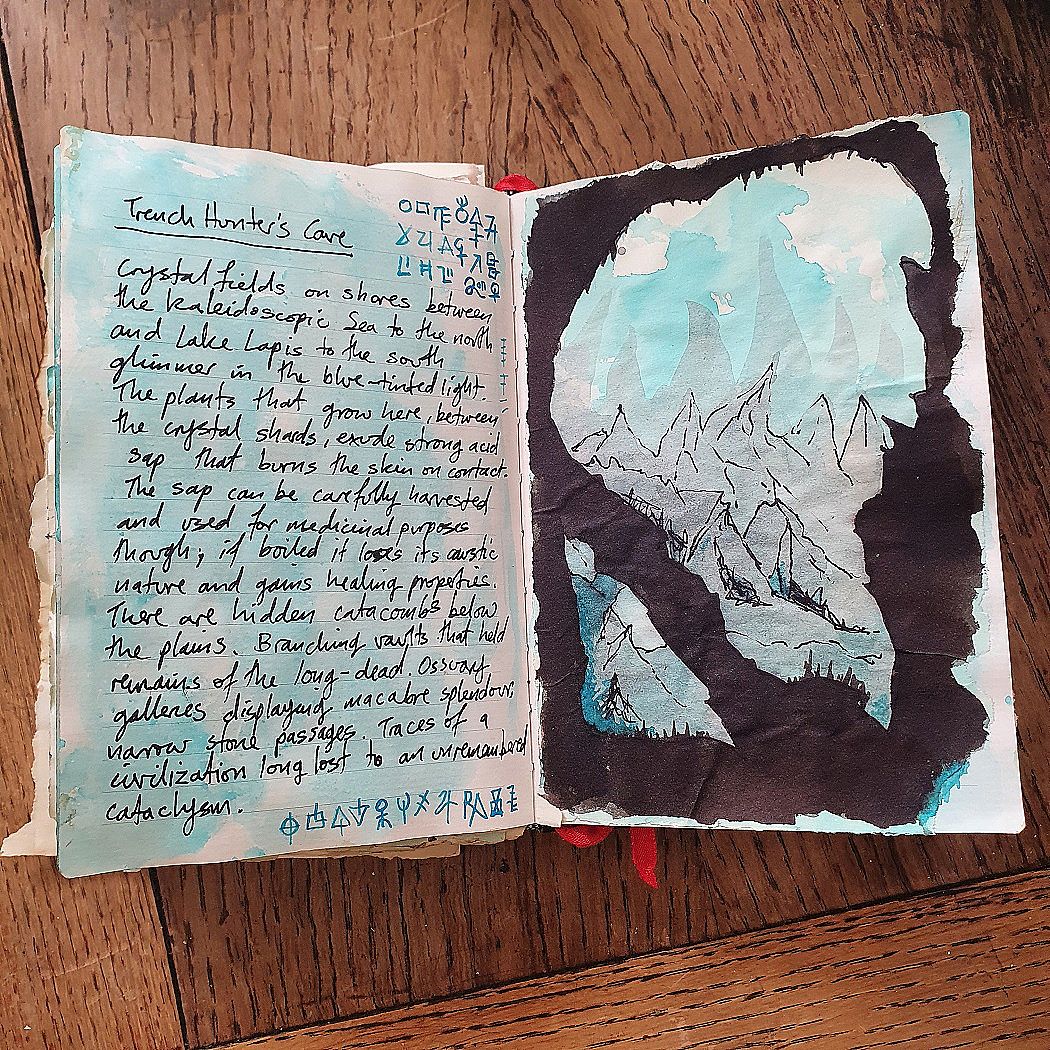
Region C34 - Trench Hunter Cove
Crystal fields on shores between the Kaleidoscopic Sea to the north and Lake Lapis to the south glimmer in the blue-tinted light. The plants that grow here, between the crystal shards, exude strong acid sap that burns the skin on contact. The sap can be carefully harvested and used for medicinal purposes though; if boiled it loses its caustic nature and gains healing properties. There are hidden catacombs below the plains. Branching vaults held the remains of the long-dead. Ossuary galleries, displaying their macabre splendour, open out of narrow stone passages. The civilization that built the halls is long lost, through some unremembered cataclysm. (Updated)
Region C34 - Reaver’s Glory
Nestled along the shores of Trench Hunter Cove, just north of Dungmoot, lies the small village of Reaver’s Glory. Originally explored by members of The Stormdance Reavers, the village’s population consists of various groups displaced by the creation of The Dragonchasm or those crew of the Stormdancer who simply chose to remain in The Scarlands. The village’s hunters often return and spend their pay drinking at The Trench’s Head tavern, constructed within the chitinous head of The Trench Hunter itself, where villagers to this day recount the various tales about the beast’s slaying.
Region C36 – Cometfall
The southern island in the Tainted Depths. A Loonshrine is hidden in the peaks, a tribe of armoured grots jealously guard it. The Loonstone is the comet after which the island is named. (Updated)
Region C37 – The Tainted Depths
A vast flood-lake that drowned the lowlands of the Ferrus Wastes and surrounded islands that were once mountains in the Wastes: the massive Ironholt and Cometfall, and the Mausoleum of Radagandron the Mad. (Updated)
Region C38 - Runepeaks
The mountains above the Glittering Hills and Copperwater are covered with strange markings, scored into the surface of the rock. The circular markings range from a few feet across to many hundreds of yards. Some can be seen from miles away. (Updated)
Region C40 - The Enigma at the Epicentre (Zakaz Awer)
Concealed in the centre of the Verdigris Mountains is a small tower built in a strange style - it only appears to be three or four stories high, but it extends downward into the stone for many, many more levels. Each level below ground is slightly wider than the one above. The shifting geometry of the architecture is disorientating and uncomfortable to look at. The blue-green stone appears to ripple and flow, back and forth with a nauseating rhythm. (Updated)
Region C42 - Spite Peaks (Karaz Bok)
The mountains between the Underbough and Lake Lapis are patrolled by flocks of aggressive flying spites. These especially large Zephyrwings seem to attack anything that attempts to climb the slopes, as if they were guarding something: and in fact the caverns, high in the peaks, where they roost are filled with millions of their eggs. (Updated)
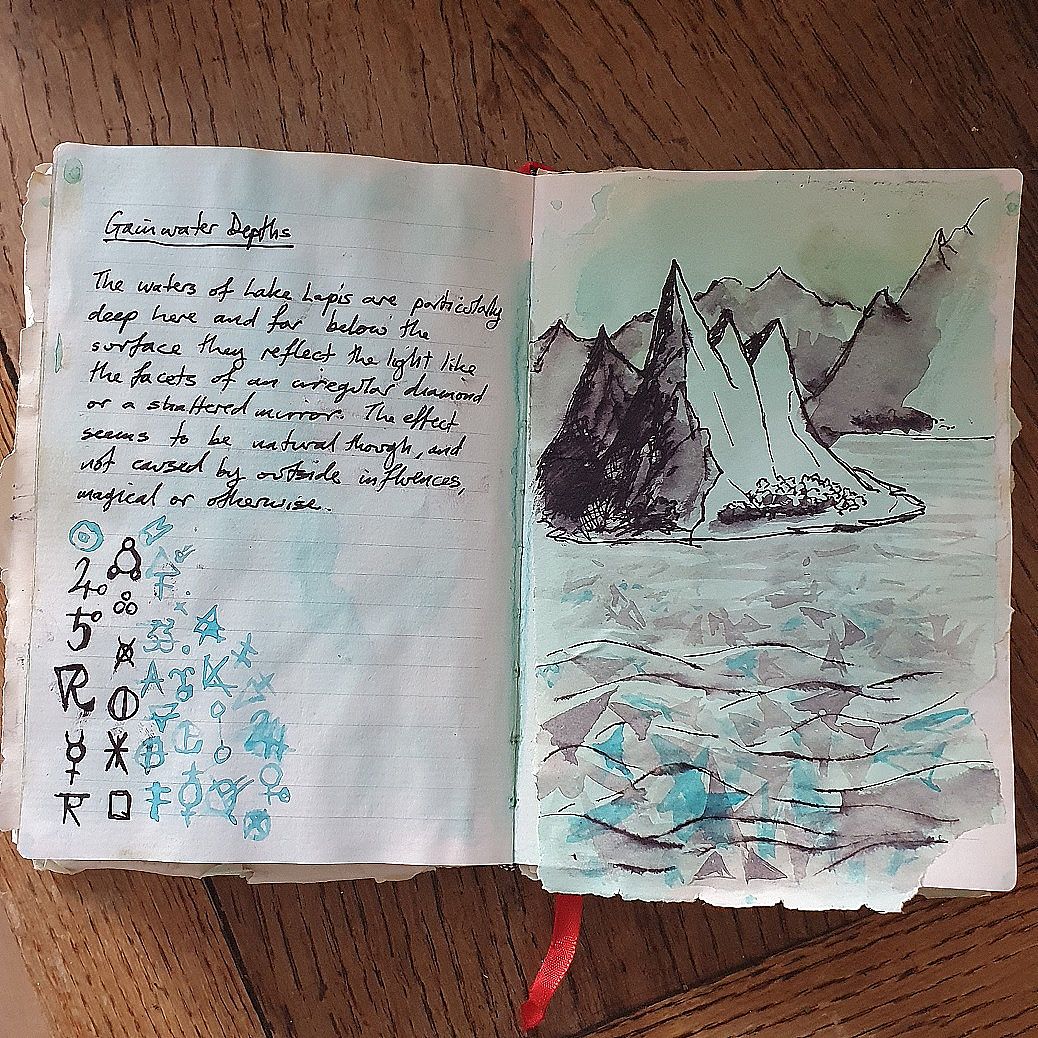
Region C44 - Gainwater Depths
The waters of Lake Lapis are particularly deep here and far below the surface they reflect the light like the facets of an irregular diamond or a shattered mirror. The effect seems to be natural though, and not caused by outside influences. (Updated)
Region C45 – The Refuge
Near a jagged precipice amidst silvered mountains, the overgrown ruins of an old fortress stand in a sunlit forest. The air here is filled with the scent of wildflowers. The castle was known as the Refuge but it has been a long time since it could provide one. Packs of bloodied Rocktusk Prowlers lurk in the shadows of the trees and ruins. (Updated)
Region C46 – Lake Lapis
The floodwaters from the Ur-River have filled the Lapis Valley and turned it into a massive lake. The Dancing Stones remain as islands in the waters, cut off from the land around them. The shoals of hungry metallic fish-like creatures that swarm through these waters will rip apart anyone foolish enough to swim in the lakes. (Updated)
Region C47 – The Dancing Stones
Two islands in the waters of Lake Lapis, with mountain peaks that are peppered with towering megalithic standing stones. The stones were erected in the Age of Myth and the just-visible carvings upon them have been worn down by time and weather. The locals will not go near them as they swear that even looking at them means certain death.
Region C51 – The Ferrus Wastes
A bleak and dusty wasteland plain that used to be much bigger – only the higher ground remains, the lower slopes were lost beneath the Glancewater by the flooding.
Region C52 – Glancewater
The flooding of much of the southern Ferrous Waste created a body of water that is broad and shallow.
Region C53 - Unnamed
The Ur-River flows south, out of the Tainted Depths and Glancewater. Far downstream is the famed port-town of Gehenna’s Rest.
Region C54 – Windrider Ridge
A grassy ridge, only somewhat higher than the water-level of the lakes on either side, beset by high winds from the mountains.
Region C55 – The Glittering Hills
Rolling hills covered in metallic-pink blossomed forest populated by unnumbered pollinating insects of varying sizes, ranging from Sulphur-stings the size of your fist to Needle-flies larger than a horse. (Updated)
Region C56 – Azoth Sound
These waters are extremely deep – it is impossible to see the bottom from the surface away from the shore.
Region C57 – Eyrie of the Sigil
An island in Azoth Sound that was the stronghold of a Tzeentchian alchemist. The silvered fort contains a fantastical library and a huge store of rare and volatile ingredients. (Updated)
Region C61 – Argent claws
Hundred-strong clusters of silvery crystals are arranged in strange geometric patterns. The air shifts around them, distorted as if by heat that cannot be felt.
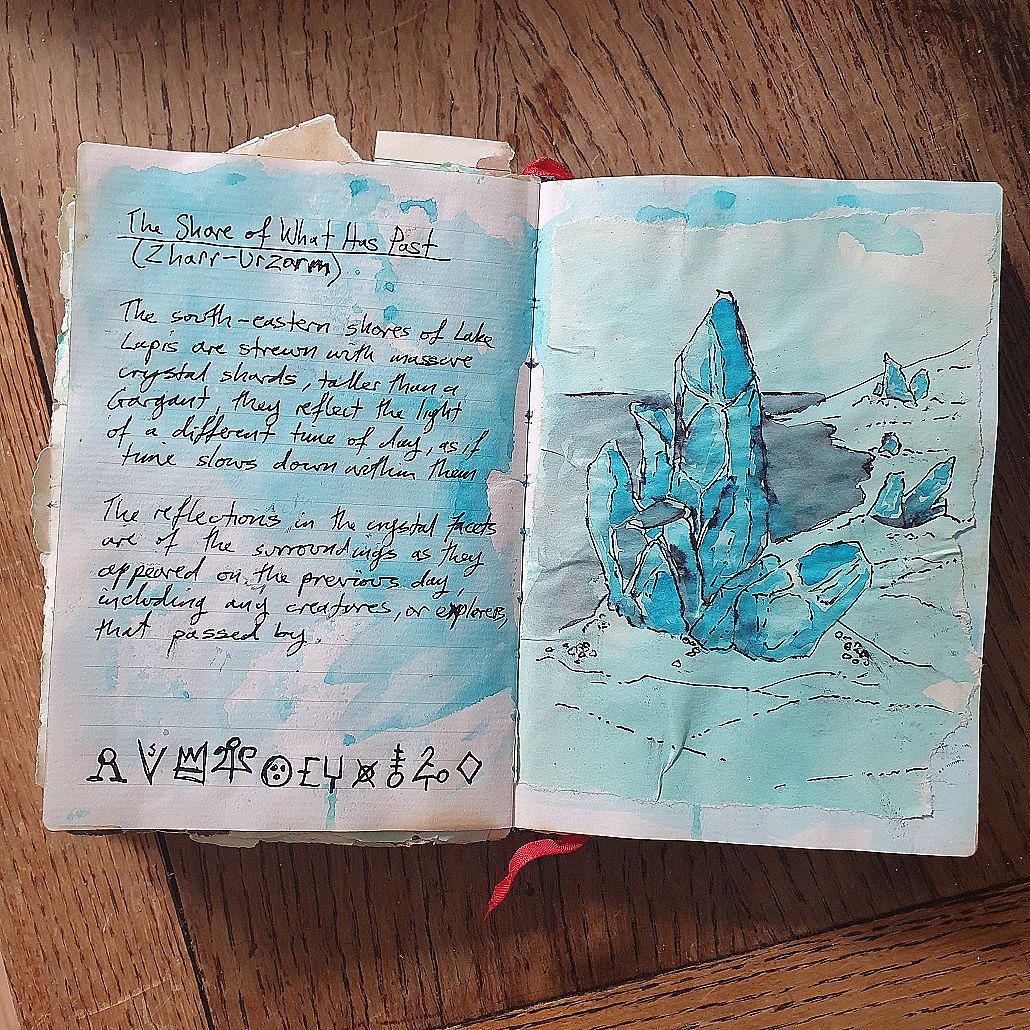
Region C63 - Shore of What Has Past (Zharr-Urzarm)
The south-eastern shores of Lake Lapis are strewn with massive crystal shards, taller than a Gargant, they reflect the light of a different time of day, as if time slows down or speeds up within them. The reflections in the crystal facets are of the surroundings as they appeared on the previous day, including any creatures, or explorers, that passed by. (Updated)
Region C64 – Forest of Rust
An orange-leafed forest that stretches on for miles and miles to the south of Silverside. No one likes to go into the woods, including wildlife.
Region C66 - Unnamed
The tail-end of the Verdigris Mountains are not as tall or impressive but they still hold many mysteries. Skyship captains have been warned to stay clear of these innocuous-looking smaller sisters.












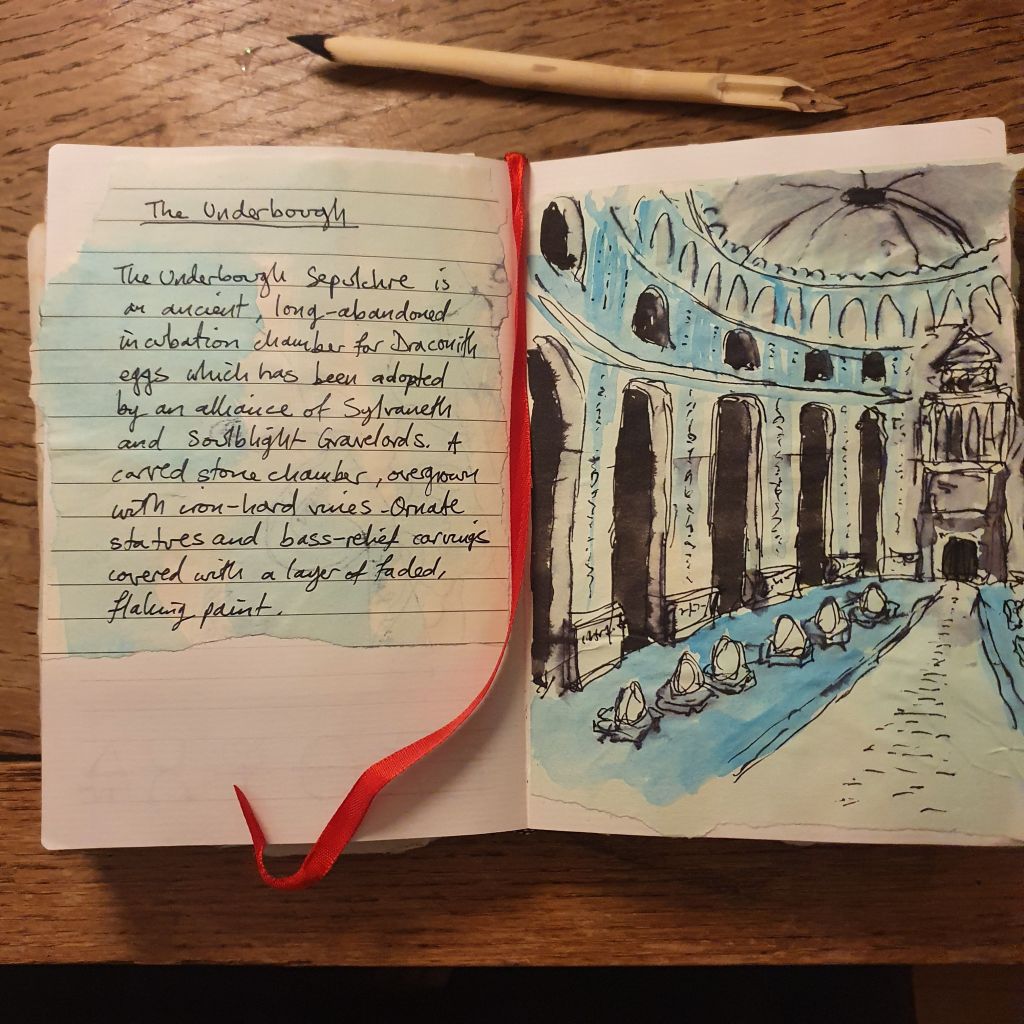












 (Turn Zero map of the Bleed)
(Turn Zero map of the Bleed) (Turn One map of the Bleed)
(Turn One map of the Bleed) (Turn Two map of the Bleed)
(Turn Two map of the Bleed)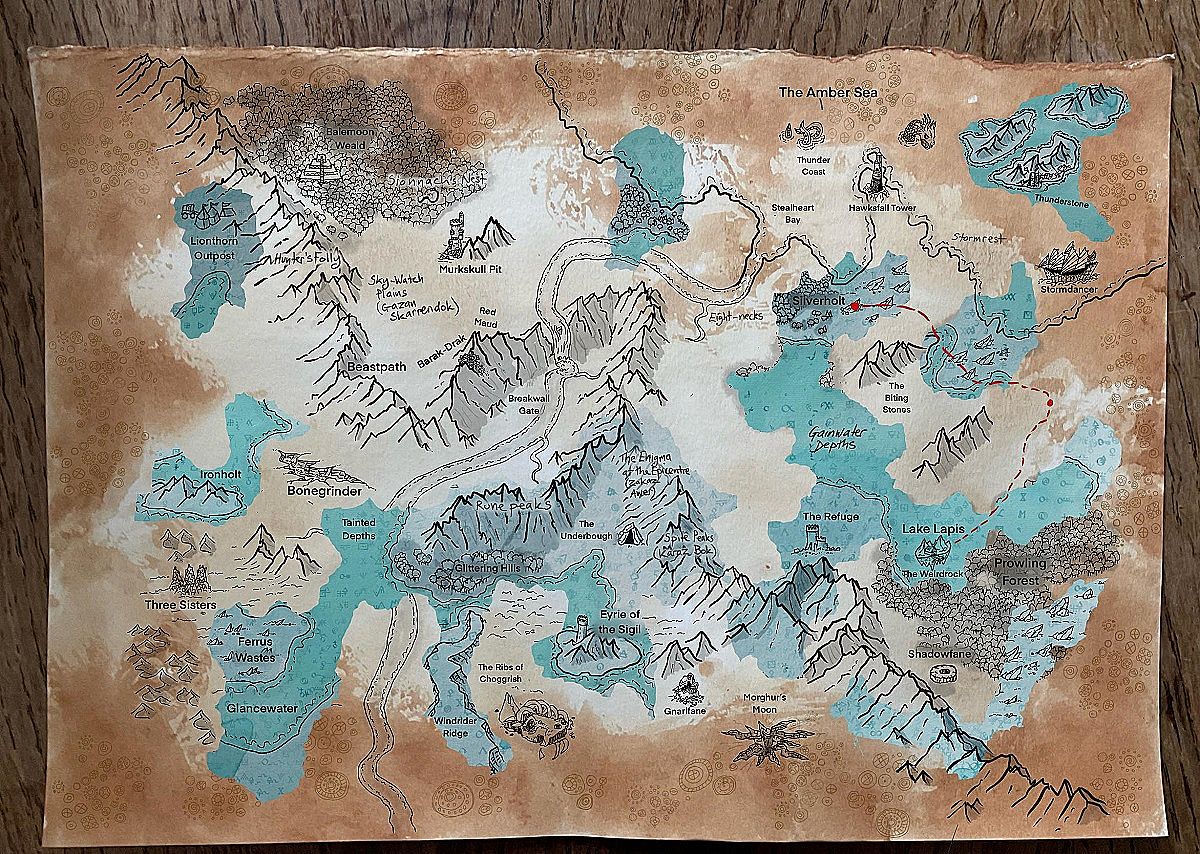 (Turn Three map of the Bleed)
(Turn Three map of the Bleed)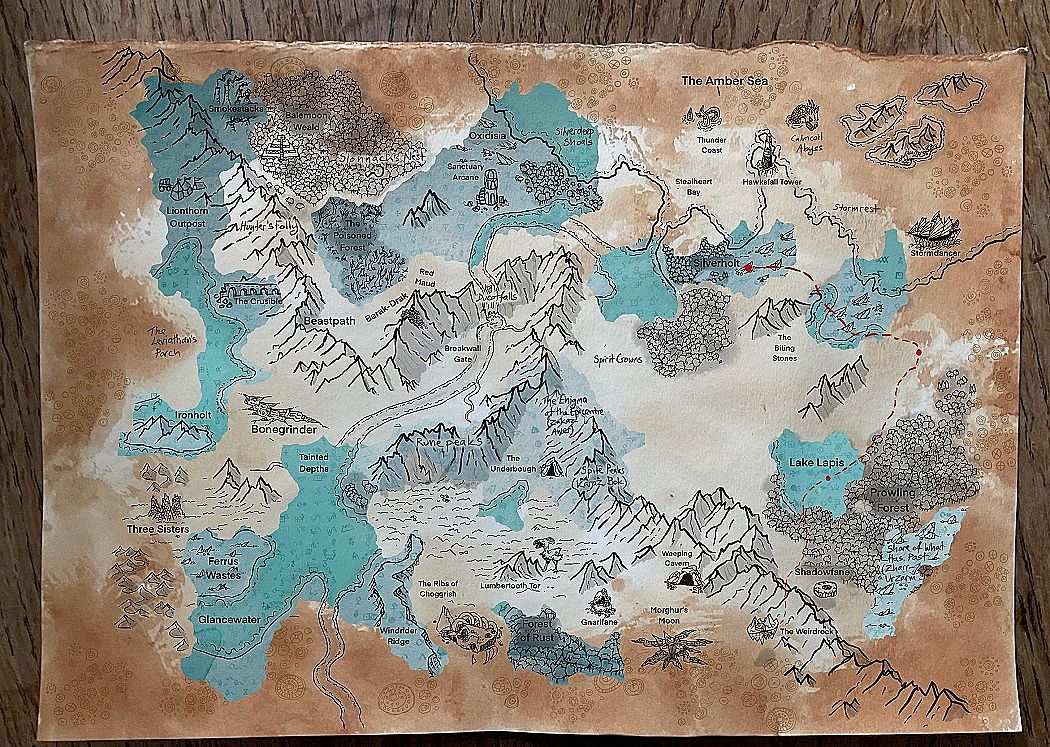 (Turn Four map of the Bleed)
(Turn Four map of the Bleed)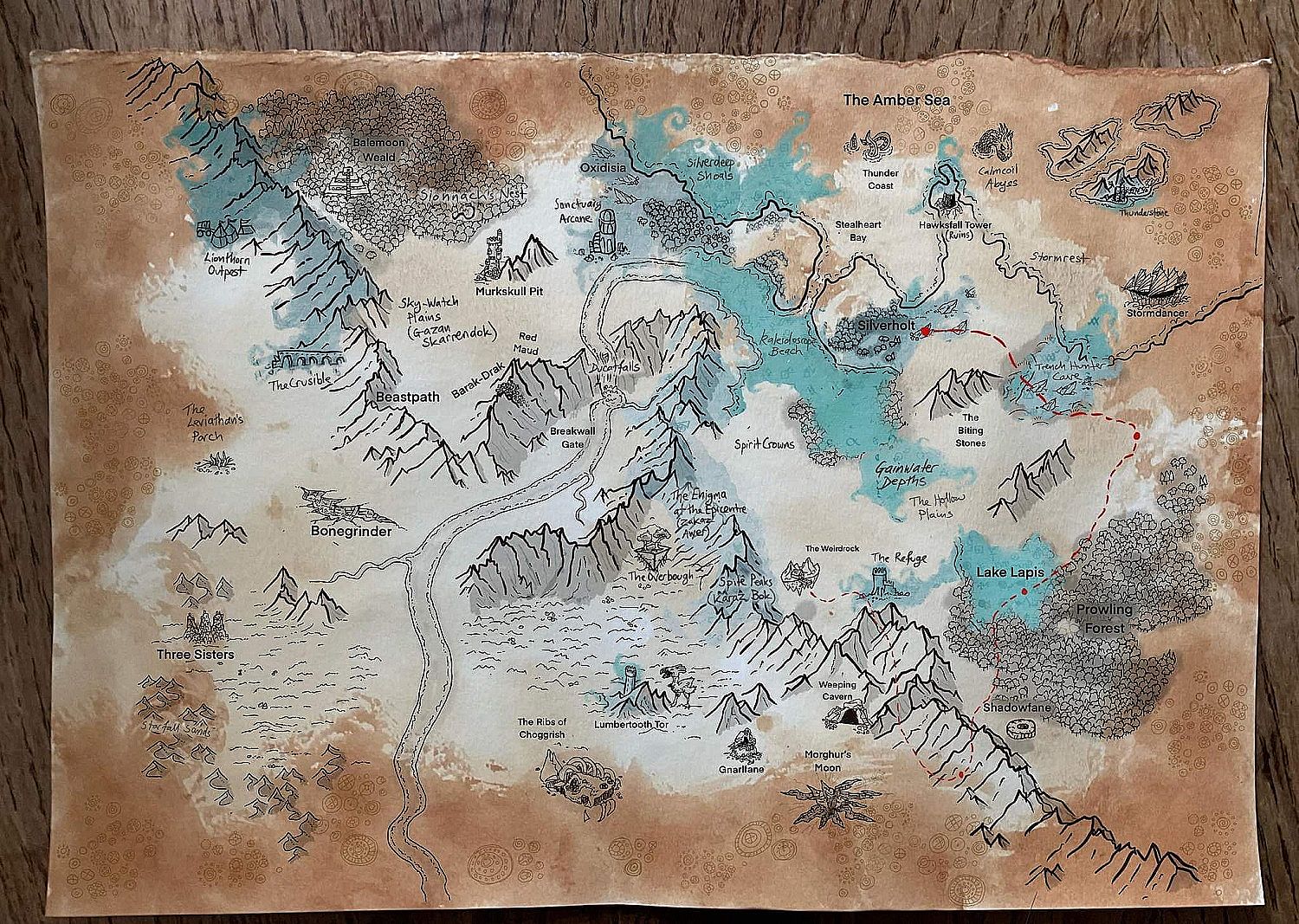 (Turn Five map of the Bleed)
(Turn Five map of the Bleed)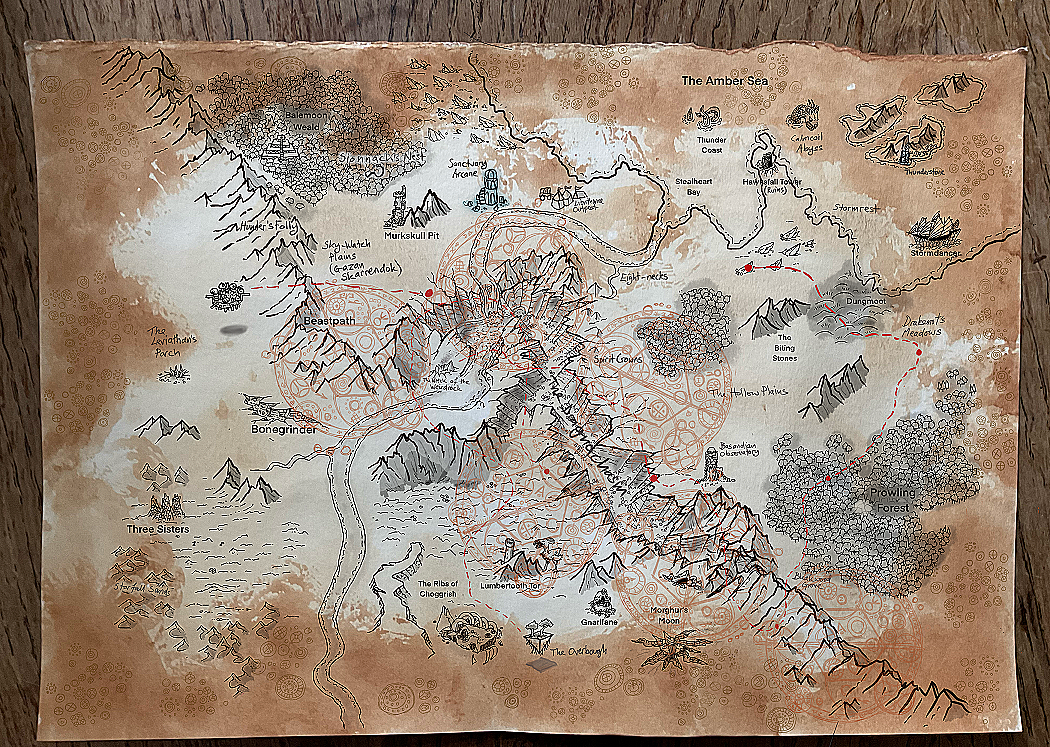 (Epilogue map of the Scarlands)
(Epilogue map of the Scarlands)